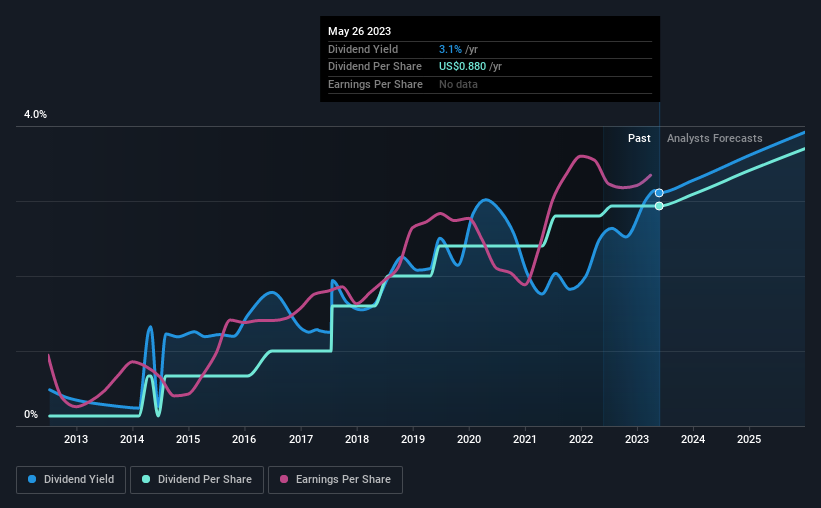There's A Lot To Like About Bank of America's (NYSE:BAC) Upcoming US$0.22 Dividend
It looks like Bank of America Corporation (NYSE:BAC) is about to go ex-dividend in the next four days. The ex-dividend date occurs one day before the record date which is the day on which shareholders need to be on the company's books in order to receive a dividend. The ex-dividend date is an important date to be aware of as any purchase of the stock made on or after this date might mean a late settlement that doesn't show on the record date. Meaning, you will need to purchase Bank of America's shares before the 1st of June to receive the dividend, which will be paid on the 30th of June.
The company's upcoming dividend is US$0.22 a share, following on from the last 12 months, when the company distributed a total of US$0.88 per share to shareholders. Looking at the last 12 months of distributions, Bank of America has a trailing yield of approximately 3.1% on its current stock price of $28.31. Dividends are an important source of income to many shareholders, but the health of the business is crucial to maintaining those dividends. So we need to investigate whether Bank of America can afford its dividend, and if the dividend could grow.
See our latest analysis for Bank of America
Dividends are typically paid from company earnings. If a company pays more in dividends than it earned in profit, then the dividend could be unsustainable. Fortunately Bank of America's payout ratio is modest, at just 26% of profit.
Companies that pay out less in dividends than they earn in profits generally have more sustainable dividends. The lower the payout ratio, the more wiggle room the business has before it could be forced to cut the dividend.
Click here to see the company's payout ratio, plus analyst estimates of its future dividends.
Have Earnings And Dividends Been Growing?
Companies with consistently growing earnings per share generally make the best dividend stocks, as they usually find it easier to grow dividends per share. If business enters a downturn and the dividend is cut, the company could see its value fall precipitously. Fortunately for readers, Bank of America's earnings per share have been growing at 16% a year for the past five years.
Many investors will assess a company's dividend performance by evaluating how much the dividend payments have changed over time. In the past 10 years, Bank of America has increased its dividend at approximately 36% a year on average. It's exciting to see that both earnings and dividends per share have grown rapidly over the past few years.
To Sum It Up
From a dividend perspective, should investors buy or avoid Bank of America? Companies like Bank of America that are growing rapidly and paying out a low fraction of earnings, are usually reinvesting heavily in their business. This strategy can add significant value to shareholders over the long term - as long as it's done without issuing too many new shares. Overall, Bank of America looks like a promising dividend stock in this analysis, and we think it would be worth investigating further.
In light of that, while Bank of America has an appealing dividend, it's worth knowing the risks involved with this stock. Our analysis shows 1 warning sign for Bank of America and you should be aware of this before buying any shares.
Generally, we wouldn't recommend just buying the first dividend stock you see. Here's a curated list of interesting stocks that are strong dividend payers.
Have feedback on this article? Concerned about the content? Get in touch with us directly. Alternatively, email editorial-team (at) simplywallst.com.
This article by Simply Wall St is general in nature. We provide commentary based on historical data and analyst forecasts only using an unbiased methodology and our articles are not intended to be financial advice. It does not constitute a recommendation to buy or sell any stock, and does not take account of your objectives, or your financial situation. We aim to bring you long-term focused analysis driven by fundamental data. Note that our analysis may not factor in the latest price-sensitive company announcements or qualitative material. Simply Wall St has no position in any stocks mentioned.
Join A Paid User Research Session
You’ll receive a US$30 Amazon Gift card for 1 hour of your time while helping us build better investing tools for the individual investors like yourself. Sign up here

 Yahoo Finance
Yahoo Finance 
